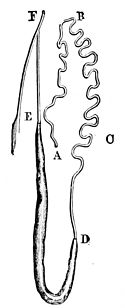grows, this organ is filled with a liquid which, in passing through the spinners, the orifice of which you see, dries in the air, and forms a thread. This thread constitutes the silk.
The nervous system of the animal, placed below the digestive tube is with insects, as with all animals, of the highest importance. It is the nervous system which seems to animate all the other organs, and particularly the muscles. The latter are what we call flesh or meat. They are in reality the organs of movement, with our caterpillar as with man himself. Each of them is formed of elementary fibres that have the property of contracting and relaxing; that is to say, of shortening and lengthening under the influence of the will and of the nervous system. Upon this property depend all the movements executed by any animal whatever.
Fig. 2.

Fig. 2. Silk-secreting apparatus of one side of a Silk-worm. Silk-secreting Apparatus of One Side of a Silk-worm. A, B, C, the part nearest the tail of the worm, where the silk-matter is formed. D, E, enlarged portion—reservoir of silky matter. E, F. capillary tubes proceeding from the two glands, and uniting in one single short canal, F, which opens in the mouth of the worm, at its under lip. Two silk threads are therefore united together, and come out through the orifice with the appearance of a single thread.
I wish you to remark, à propos of the caterpillar—of this insect that when crushed seems to be only a formless pulp—that its muscular system is admirably organized. It is superior to that of man himself, at least, in relation to the multiplicity of organs. We count in man 529 muscles; the caterpillar has 1,647, without counting those of the feet and head, which give 1,118 more.
In us, as in most animals, there exists a nourishing liquid par excellence that we know under the name of blood. This liquid, set in motion by a heart, is carried into all parts of the body by arteries, and
